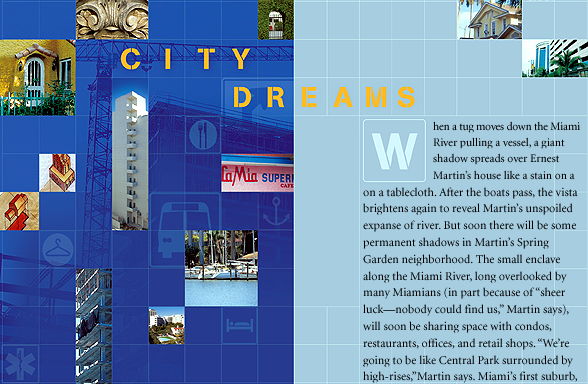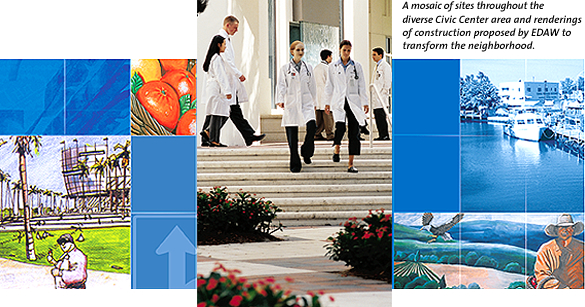 |
|
 |
Circled by major highways like State Road 836 and I-95 and encompassing Miami’s major medical education, research and treatment centers, and judicial departments, the Civic Center area, bustling by day, becomes a ghost town at night. All that is about to change. The Civic Center is undergoing a transformation. And while part of Martin mourns the end of the neighborhood as he’s known it, another part is glad because it is The Miami Partnership shepherding the change. “We know growth is inevitable. We want to make sure that the existing area that reaches back for several generations remains. But this is a treasure that we’re glad to see the Partnership recognizes and wants to preserve,” Martin says.
The Miami Partnership, spearheaded by University of Miami President Donna E. Shalala and City of Miami Mayor Manny Diaz, is an ambitious initiative to revitalize the Civic Center area. Joining the University and the City of Miami are the schools, hospitals, judicial centers, private and public sector businesses, and neighborhood associations, all banded together in a movement to make the Civic Center area an ideal place in which to live, work, and play. Because the Leonard M. Miller School of Medicine is a major tenant of the Civic Center, the school is playing a prominent role in The Miami Partnership.
The idea for The Miami Partnership originated with Sergio Rodriguez, the University’s vice president of real estate, campus planning, and construction, and his staff, in cooperation with the Miller School. They invited EDAW, an international design and planning firm that brought top design, architecture, and urban planning students from across the world to study the Civic Center in 2002. Working with the input of EDAW professionals and community and professional representatives, the students came up with an overall plan for the area incorporating urban design strategies to make it more livable.
Many of The Miami Partnership’s stakeholders, like local resident Ernest Martin and Paul K. Glasser of Jackson Memorial Hospital, took part in that initial planning. “I was studying to be an urban planner before I got involved in a different life,” says Glasser, the hospital’s vice president of plant operations and facilities. “So the whole notion of redoing this area in a nice urban fabric had me very, very excited.”
It’s an excitement that Glasser maintains three years later. And perhaps more strikingly, everyone involved in the comprehensive project is still feeling that first burst of enthusiasm. “The glass is definitely half-full because things are really happening,” Glasser says.
“Years ago, it was ‘We’re going to redo Overtown,’ and we built an arena and that’s about as far as it went. But we didn’t have the mayor’s drive, we didn’t have the county commission’s drive, and we didn’t have the stakeholders. Whoever put this partnership together was very on target with what they did.”
Martin, a retired community and economic
development planner, agrees. “A
lot of times, plans get done that look like a lot of fun—and then end up
gathering dust on the shelf. I don’t think this one will.”
Live, Work, and Play
![]() ore
than 272,000 vehicles a day travel on some segment of I-95 in Miami-Dade
County. Nearly 30,000 people work
in the Civic Center. If you’re one of
the more than 17,000 Civic Center employees who live more than 20 miles away,
you are very much aware of your thousands of fellow commuters.
ore
than 272,000 vehicles a day travel on some segment of I-95 in Miami-Dade
County. Nearly 30,000 people work
in the Civic Center. If you’re one of
the more than 17,000 Civic Center employees who live more than 20 miles away,
you are very much aware of your thousands of fellow commuters.
One of The Miami Partnership’s goals is to develop adequate housing in the area to lure residents out of suburbs—and their cars—and into neighborhoods that are within walking distance from where they work. Developers are already picking up on that interest: More than 7,476 residential units are either under construction or on the board that might serve the Civic Center area. Dan McCaffery, a Chicago developer, is one of those “intending to build” in the Civic Center. McCaffery aims to put up a mixed-use development consisting of homes, retail shops, restaurants, and offices on the seven-acre site where the Mahi Shrine is located at North River Drive and 13th Street.
 |
|
 |
McCaffery, who has similar developments in cities such as Washington, D.C., San Francisco, Chicago, and Minneapolis, was sold on the spot before any marketing data was compiled on the area (an economic impact study commissioned by The Miami Partnership has subsequently been published). “You never know about these things,” McCaffery says, “but I was taken immediately by two things: the intensity of the people around the area; at 10:30 in the morning, there was this hub of people all around there. I was also struck by the beauty of the Miami River.” McCaffery went back to the site at 8 p.m. and was struck this time by the total absence of anyone on the streets at night. But McCaffery is still convinced that the market is there. He isn’t banking on the belief that “if you build it, they will come.” He feels the people have already come—what’s missing are the services to keep them there.
It’s not going to be easy to persuade people to move to the Civic Center, despite the attraction of an effortless commute. Even the area’s longtime residents would admit that it has been a struggle to live there at times. Spring Garden has had its problems, including what Martin calls a ten-year war over who would win the neighborhood, the residents or the criminals. “We won,” he says.
That’s why the Miami-Dade State Attorney’s office became involved with the Partnership. Ed Griffith, spokesperson for the state attorney, says his office sees a direct correlation between the quality of housing and crime. “The state attorney has done things in the past regarding poor housing conditions, so improving housing conditions would have a positive impact. Poor housing leads to increased crime—better housing leads to decreased crime,” Griffith says.
The area still lacks retail and everyday living services, like dry cleaners and convenience stores. Despite the urban setting, neighborhood residents like Martin have had to get in their cars and drive for groceries and restaurants, just like their suburban counterparts. That’s where the city comes in.
“The government’s principal role is with the infrastructure—cleaning the river, cleaning the streets, mass transit improvements, promoting residential development and employment in the area. We’re looking at possibly changing zoning, fixing streets—it will develop year by year,” says Mayor Diaz.
The government’s infrastructure and the private sector’s contributions will help bring in the schools, transportation, parking, housing, green space, food, and entertainment to get people to want to live there. The next piece of the equation centers on jobs—new jobs, different industries, and an expanded employment base.
A dream of President Shalala is to see the Civic Center area develop into a biotech corridor that is fed by—and in turn feeds off of—the Miller School of Medicine’s faculty and its discoveries. Several other universities enjoy this kind of parallel relationship, which bolsters the economy of the surrounding area, such as the Research Triangle in North Carolina or the technology center surrounding the University of Pennsylvania.
The University is doing its part to promote that kind of economic development. The Miller School recently received a $13 million grant to establish the Wallace H. Coulter Center for Translational Research, which will fast-track promising research from scientific laboratories to patients’ bedsides. President Shalala sees this as one of the first steps in creating a new biotech hub. “We create knowledge at the School of Medicine. And we will spin off those ideas into science and private enterprise through our faculty members, who will create private businesses,” President Shalala says.
“We need high-quality jobs in Miami. We have jobs, but we need high-paying, high-quality jobs for people who are highly educated. Students from the University of Miami who graduate, even if they’re from Iowa, want to stay in Miami. But they’re struggling to find jobs here that meet their skills. And so we need to create more jobs that are well paid.”
Mayor Diaz agrees. “Those who focus on economic development oftentimes focus on bringing in industry, and I’m a firm believer in working with what you have,” he says. “We have a real gem in the Civic Center.”
There are signs that people are starting to recognize that jewel in the rough. Michael Connolly, Ph.D., is professor and chair of economics at the University. He currently lives and works just a few minutes away from the school’s campus in Coral Gables. But he’s planning to retire in a few years, and he’s already bought his retirement home—in the Civic Center. “It’s a bet on the future,” Connolly says.